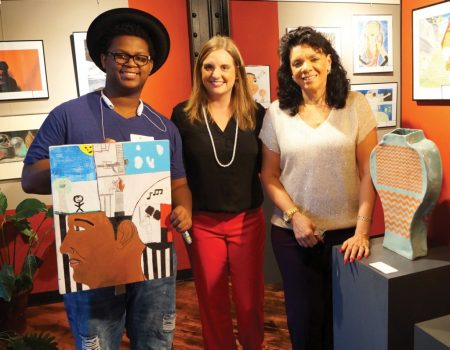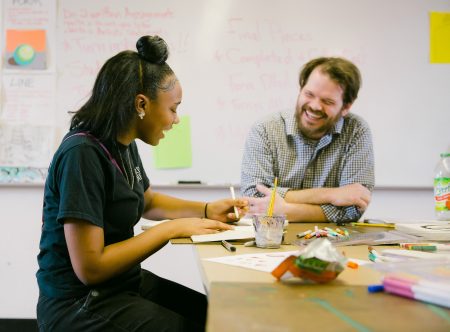Many people may not have heard of Cincinnati Arts and Technology Studios (CATS), a non-profit agency that uses the power of the arts and other proven methods to help at-risk students stay in high school, graduate and succeed in life through art studio courses in fine arts, college and career preparation and Bridging the Gap, a workforce development program.
Chief Executive Officer Clara E. Martin said, “This is a well-kept secret.” But, this year, she is making an intentional effort to obtain more community awareness of CATS, located at Longworth Hall, 700 Pete Rose Way, in downtown Cincinnati. Martin has hired a full-time PR person and development director who are working with the board’s marketing/development committee to executive strategic goals.
The Cincinnati region is ranked #4 nationally in child poverty, according to United Way. As a result, CATS reached out to at-risk students from fifteen public high schools, such as Aiken, West High, Withrow, Riverview East and Gamble. CATS do not serve the School for the Creative and Performing Arts (SCPA) and only a limited number from Walnut Hills High School.
The program helps seniors graduate from high school, gives them college options and gets them into career paths. Martin said that CATS follow students for 18 months after leaving the program.
The agency, in existence for sixteen years, has served over 4,800 students. CATS staff recruits kids at school assemblies and hosts them at Longworth Hall. Students receive an enrollment packet. “We don’t turn anyone away,” Martin said.
The kids, transported by a bus, take morning studio courses as well as from 3 pm to 5 pm and 4 pm to 6 pm in the afternoon. Nationally certified arts teachers supervise the courses. They find that many have a proclivity in art that they didn’t realize. “It can become an emotional outlet,” Martin said.
Students follow a guild model where they work closely with practicing artists who exhibit and sell their art locally, regionally and internationally. Studio courses include digital multi-media; two-dimensional art, including drawing, painting, pastels, print-making and collage; three-dimensional art; ceramics; and stained glass.
Ten teachers form the backbone of the CATS program. Kids can choose various media in which they want to work. CATS staff invite in parents from time to time. Although Martin says, “We’re a lot different than schools, we want to keep our parents informed and supportive.” There are five staff members in addition to teachers.
To round out their course work, students take twice-annual trips to such places as the Carl Solway Gallery, Weston Gallery, Cincinnati Art Museum and Contemporary Arts Center. They apply their knowledge to translate their field of study to artists and their artworks in the museum.
“We are a unique culture,” she added. “It is not the typical school vibe. Kids are practicing for college and their career. We do have expectations for the kids. The message is that adults can be successful, and we provide models after the professional world. We talk about what’s required and mirror the work world. Students need to be timely and responsible; they need to enjoy collaboration.”
“The kids want to be successful. They grow in wanting to be young adults and graduate from high school. We get them installed in an adult world,” Martin said.
To help with these transitions, a social worker from Cincinnati Public Schools and a retired psychologist help the kids understand the mental health world. They provide a tight net of support for the kids.
The origin of CATS goes back to William Strickland, a Pittsburgh social entrepreneur, who gave a speech in 2001 to city leaders as he described his mission of providing underserved people the mentoring and training to create meaningful lives. He returned in 2002 to meet additional community leaders to discuss and build support for replicating his Manchester Bidwell Center in Cincinnati.
In 1968, Strickland founded the Manchester Craftsmen’s Guild, a tiny neighborhood arts center that grew into Manchester Bidwell, a jobs training center and community arts program whose mission is to turn around lives. There are classes at Craftsmen’s Guild for younger students and the Bidwell Training Center for adults. There are 150 people on staff, and 1,200 students have passed through the doors.
Many of the Center’s board members and founders, including philanthropist Lee Carter, Reds owner Bob Castellini and former Biggs executive and Awakenings owner Pierre Wevers visited the Pittsburgh center when they were considering adopting the program.
As a result, the Cincinnati Arts and Technology Center (CATC) is the product of these efforts. Providing economic inclusion and educational attainment for the city’s low income and underserved population became the charge of CATC when it opened its doors in 2003.
As a struggling high school student, Strickland took ceramics which later transformed his life. “The magic I felt when I first laid my hands-on wet clay gave me the belief that I could do something interesting with my life,” he said. A neophyte potter, he found making pottery one of the great joys of his life.
“Those insights not only gave me a vision of my future, they literally saved my life,” he added.
“That’s the power of art,” Strickland said to a class. “Art is a bridge. It connects you to a wider world, to a broader experience. I don’t expect a bunch of poor kids from the streets to become overnight aficionados because they see a pretty picture, but don’t try to tell me that exposure to the arts doesn’t have the power to change a human being. It gets in their bones, man. That is the power of the arts in our lives.”
He also reached out nationally to create centers similar to Manchester Bidwell. There are others in San Francisco, Israel, Pennsylvania, Boston and New Haven, for example.
“In his book, Make the Impossible Possible, Strickland demonstrates how each of us, by adopting the attitudes and beliefs he has lived by every day, can reach our fullest potential and achieve the impossible in our lives and careers – and perhaps change the world a little in the process.”
Strickland is president and CEO of Manchester Bidwell and now serves on the board of CATS, which changed its name from CATC in 2016 to better reflect what the center does based on focus groups.
CATS see over 90% of the students graduate from high school, and 89% of the young adults continue with the same job at least one year later. Hundreds of students enter the Bridging the Gap program and go on to entry level jobs or college.
Leadership Cincinnati Class 33 wanted to address the severe shortage of health care workers in 2010. Members worked with CATC and Cincinnati Children’s Hospital Medical Center to increase the number served, add services, create sustainability and positive outcomes of a program called Bridging the Gap. BTG found 86 kids employed as of spring 2018.
Bridging the Gap earned a $150,000 grant from the Cincinnati/Northern Kentucky Social Innovation Fund in 2011.
The program expanded to include positions and employers in the manufacturing sector in 2012. Certifications in technology became available in 2017.
Students interested in Bridging the Gap apply and follow a rigorous process. This includes life skills training, job-readiness workshops, state certification and training for testing, hiring and job interviews. An important part of the program is assignment of an on-the-job mentor. CCHMC, Christ Hospital, Cincinnati Works, Per Scholas and PNC Bank offered entry level jobs.
To cap off their academic year, students held their 11th Annual Student Show & Sale called “Spring Fever: Opposites,” from 3 to 6 pm on Saturday, April 13 at CATS. The exhibit showcased achievements in all media by CATS students. With one theme every semester created by Education Director Laura Greene, kids are given ways of dealing with life through art. In addition to life skills, lessons in positive thinking are given to produce good things from the concrete to the abstract.
Another CATS exhibit will be at Gallery 708, 708 Walnut St. in downtown Cincinnati on Sunday, April 28 from 1 to 3 pm.
Funding, as it is with many nonprofits, comes from foundations, individuals and corporations. This year, CATS is running in the black. That always wasn’t the case, according to Martin.
Both Fifth Third Foundation and Procter & Gamble have awarded scholarships to CATS students.
Martin would like to offer more services, more jobs and better transportation for the kids to get to jobs. Oftentimes, there’s no bus.
She started her career in special education, then regular education and eventually went on to receive her M. Ed. and moved into administration before she “retired.” Martin, who joined the organization in 2008, said, “I love doing this. I love the kids,” Martin said. “This is great for me to see the kids launch into adulthood. It’s a great way to end your career,” she added. “You can do what is right for the kids.”
CATS partners with various non-profits such as Cincinnati Public Schools, Cincinnati Youth Collaborative and University of Cincinnati DAAP (Design, Architecture, Art and Planning). CYC, for example, provides an on-site college resource center.






